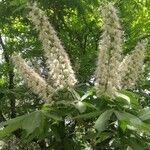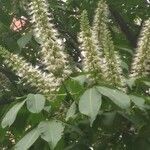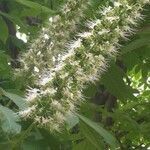Trees to 25 m tall, to 2.5 m d.b.h. Branchlets glabrous or puberulent to densely villous when young. Petiole 7-15 cm, grayish puberulent or glabrous; leaf blade 5-7(-9)-foliolate; petiolules 0.5-2.5(-3) cm, grayish puberulent or glabrous; leaflet blades oblong-lanceolate, oblong, oblong-oblanceolate, or oblong-obovate, 8-25(-30) × 3-8.5(-10.5) cm, abaxially glabrous, grayish tomentose on veins (sometimes only when young), or ± uniformly grayish tomentose or villous, base cuneate to broadly so, rounded, or slightly cordate, margin serrulate or crenulate-serrulate, apex abruptly acuminate; lateral veins in 13-25 pairs. Inflorescence puberulent or glabrous; peduncle 5-10 cm; thyrse cylindric, 15-35 cm, 2.5-12(-14) cm wide at base; branches 2-4(-6) cm, 5-10-flowered; pedicels 2-8 mm. Flowers fragrant. Calyx 3-7 mm, abaxially puberulent or glabrous. Petals 4, white, with yellow spots, subequal, oblong-obovate to oblong-oblanceolate, 8-14 × 3-5 mm, abaxially puberulent. Stamens 6 or 7, 18-30 mm; filament glabrous; anther 1-1.5 mm. Style glabrous or villous except at apex. Capsule yellowish brown, ovoid, globose, obovoid, or pyriform, 3-4.5 cm, densely dotted but smooth; pericarp 1-6 mm thick after drying. Seeds 1 or 2, brown, globose or subglobose, 2-3.5 cm in diam.; hilum white, occupying less than 1/3 to ca. 1/2 of seed. Fl. Apr-Jun, fr. Sep-Oct.
More
A tree which grows to 25 m tall. It spreads to 10 m wide. Seeds can be 3 cm across. The flowers are in a cylinder shaped panicle. They are white. These can be 45 cm long. The fruit are oval capsules 3-5 cm across. There are 1 or 2 brown seeds. They are 2-4 cm across.
It is a temperate plant. It occurs naturally in the mountains of Szechuan Province in North China. It prefers a deep loamy well drained soil but will grow on most soils. Trees are very hardy when dormant. They probably do best in a continental climate. This is hot summers and cold dry winters. It suits hardiness zones 6-9. In Sichuan and Yunnan.
More
Broad-leaved forests, near streams in tall shady forests, woods, thickets, mountain and hill slopes, ravines and roadsides at elevations from 600-2,000 metres, occasionally to 2,300 metres.



